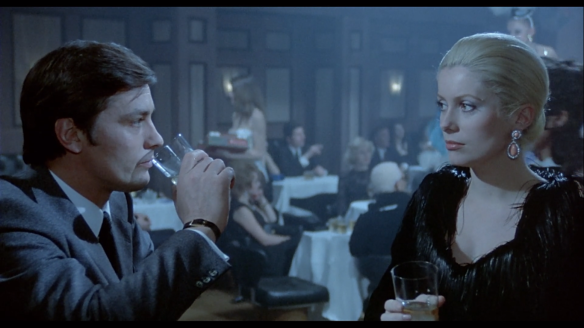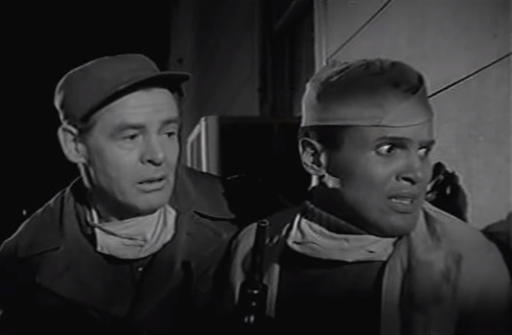
I couldn’t help being reminded of Melville’s Un Flic catching the opening of Claude Sautet’s movie. There’s a policeman, 80 grand missing, and two dead after a heist. It’s not the events that are the same, but the initial sensibilities, the palette, even the world they exist in.
Because Sautet’s hero of choice is Michel Piccoli and not a dashing, virile specimen like Alain Delon. More fallible, morose, and passionate in both his failures and his underlining convictions. In fact, Piccoli’s Max, ironically, shares more in common with Popeye Doyle from The French Connection, exhibiting an unassailable nose for catching criminals under any circumstance.
However, because he hails from across the pond, Max never seems so abrasive and thuggish — there’s a cunning restraint to all the tricks he pulls. In a former life, we learn he used to be a judge but after letting up on a would-be-murderer, he turned his back on the career. Now he catches the criminals where they lie — obsessed with “cast-iron proof” as the chief inspector (Georges Wilson) ruefully observes. He fits somewhere elusively in-between those prior reference points.
For some, Max and the Junkmen might give off the pretension of a talky picture. We get news of this opening heist that ruins Max’s reputation — his informant gave him misinformation — and yet we never see anything. Instead, we are met with the aftermath, in the patrol car, getting word from his superiors, having a meal where he broods over his failures and what he plans to do about them.
Finally, something happens. Max runs into an old acquaintance who deals in scrap. It’s what he’s been waiting for — a spark — and an idea has been conceived in his mind. He’s all but inscrutable as he readies his plans.
All we can do is wait and in the meantime, Sautet explores more of this cinematic space; it’s livelier and more organic as exemplified by Saidani’s Cafe — the people, even the colors are more vibrant. And while they’re no doubt constructed in some fashion, there’s not the same singular sense of a world being totally sculpted to a vision like Melville’s, even down to the sartorial touches and the bushido-like ethics.
Still, to his credit, Sautet tackles the heist film in a way I’ve never seen and that deserves some recognition. Of course, we’re on the side of the cops instead of the robbers, not an altogether revolutionary perspective on its own. However, as time progress, we realize how cunning the cops are and how foolishly naive the criminals play opposite them. Each of these men is given an introduction of sorts as a policeman relates who they are. It’s not a lot, but it seamlessly tells their stories and bonds them to the audience.
They’re strictly no-name hustlers caught in the pincers of a calculating beast, men barely deserving the title of criminals at all. It’s this element teasing out the almost comic connotation in Max and The Junkmen. Under slightly different circumstances, it could play as some sort of farcical caper.
It’s not merely a contrivance of a story, it’s a totally contrived crime on the inside just so a cop will have an excuse to bring some two-bit, low caliber nobodies in. This is the anatomy of a heist where he’s planning how to nab them even before the idea has ever entered their simple heads to attempt robbing a bank.
This is how far Max will go because we realize soon enough he’s going through his elaborate setup just so he can nab someone — just so he can regain some semblance of justice to right his reputation. He does it through the means of a woman.

All these plans begin rather deliberately, setting their course and biding their time. However, once Piccoli and Romy Schneider get together the film alights on a compelling relational path. We want to see how they will interact with one another, how their curious relationship will be resolved because hanging in the balance are romance, crime, and justice. Any number of things.
However, we must acknowledge something. Romy Schneider is a cinema icon even outside of the bounds of any of her pictures. Her mere presence feels ubiquitous somehow. It’s easy to liken her to a bit of Dietrich or Betty Bacall, but instead of a husky voice and mid-century roots, she’s all 1970s, liberated woman. And yet with the generational difference, under the surface, human beings are still very much the same. Sautet seems most enamored with this reality. Her voice is softer though defiant when necessary. Independent and still trusting and vulnerable at its core.
Because Max sets up a scenario to totally exploit her. He’s a banker searching out female company, knowing full-well Lily’s boyfriend, Abel (Bernard Fresson), is one of the junkmen he’s gotten a line on. They build trust. He pays her well. They don’t do anything. She finds him peculiar and yet they keep on meeting. Then the hints start coming out slowly. He starts dropping information to make its way down the line. And finally, she takes the bait innocently, as the willing mechanism with which Max looks to nab these crooks. And what’s worse is that they also take to it so easily.
He’s got everything he wants. The police in the precinct have been notified. They’ll block off the streets. There’s an inside man at the bank. They’ve closed it off. It’s the epitome of overkill. The dumb fools haven’t got a prayer.
It’s around this time the shades of Notorious come into sharper focus. The so-called villains feel like the victims. The woman of ill-repute is the betrayed stooge. Our proposed hero somehow feels like the most antagonistic character of them all, and he’s so blinded by his task, when he feels twinges of love for someone, even as he’s manipulating her, there’s this inner crisis of conscience.
Hitchcock lets his protagonists walk out the front door in a harrowing bit of showmanship. Max and the Junkmen has its own devastating finale, which proves wrenching, if not altogether unexpected. Romance has a way of complicating any methodical situation we devise as human beings. Max is tripped up in the same manner. He cannot be a cold-blooded pragmatist even if he wants to; he chooses tragedy instead.
One almost forgets that the whole course of the movie was a flashback because, when it started, we hardly knew who Max was nor that his life would involve a woman who would touch him so.
By the end, getting all the answers doesn’t matter anymore; we’ve been shaken to our core with lives capitulated to unceremonious ends. Like Un Flic or The French Connection, Max and The Junkmen has no space for a happy ending.
4/5 Stars















 The rain is pouring down. A group of men sits in silence in truck cabs their heads full of all sorts of thoughts. Two more sit in the rear hoping the explosives sitting in their stead don’t decide to go Kablooie over the next bump. Nary a word is spoken, the entire sequence playing out in silence except for the inner monologues of each man.
The rain is pouring down. A group of men sits in silence in truck cabs their heads full of all sorts of thoughts. Two more sit in the rear hoping the explosives sitting in their stead don’t decide to go Kablooie over the next bump. Nary a word is spoken, the entire sequence playing out in silence except for the inner monologues of each man.